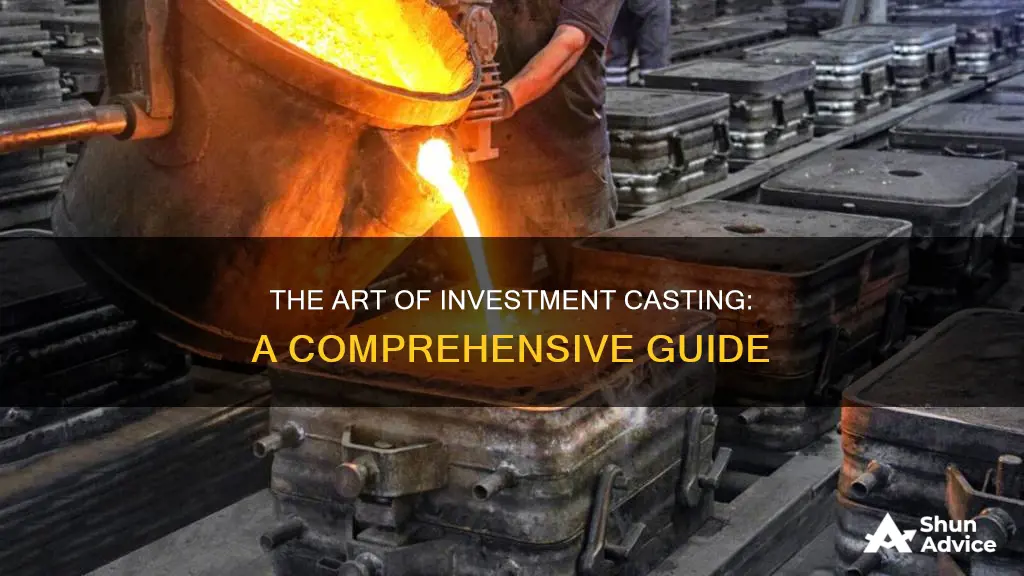
Investment casting, also known as lost-wax casting, is a manufacturing process that has been used for over 5,500 years. It involves creating a wax model, which is then coated in a ceramic material. Once the coating is dry, the wax is melted and drained, leaving a cavity that can be filled with molten metal. This process can be used to create a broad range of products, from turbine blades to jewellery, and is known for its ability to produce parts with tight tolerances and complex inner cavities.
| Characteristics | Values |
|---|---|
| First Step | Tooling Making |
| Second Step | Wax Injection and Pattern Assembly |
| Third Step | Shell Coating |
| Fourth Step | Casting or Pouring |
| Fifth Step | Shell Removing |
| Sixth Step | Heat Treatment |
| Seventh Step | Shot Blasting/Sand Blasting |
| Eighth Step | Anti-rust Oil Painting & Surface Treatments |
| Ninth Step | Quality Inspection |
| Tenth Step | Packing |
| Materials Used | All-metal alloys |
| Process Name | Lost-wax casting |
What You'll Learn

Wax pattern creation
The wax pattern assembly is then dipped into a ceramic slurry and coated with a refractory material to create a shell. This process is repeated several times until the desired thickness and strength are achieved. The shell is then dried and hardened, and the wax is melted and drained out, leaving a hollow ceramic shell called the mold.
The type of wax used in the investment casting process is important. Common types of waxes include filled pattern wax, non-filled pattern wax, runner wax, sticky wax, and water-soluble wax. Filled pattern waxes contain additives such as ceramic or metal powders to enhance mechanical properties and dimensional control, while non-filled pattern waxes are simpler and do not contain any additives.
The creation of the wax pattern is a crucial step in the investment casting process, as it ensures the final metal part meets the desired specifications. The wax pattern is an exact replica of the final metal part, and any imperfections or defects in the wax pattern will be reflected in the final casting.
Brexit-Proof Your Investment Portfolio: Strategies for Volatile Markets
You may want to see also

Wax Injection and Pattern Assembly
Wax Injection:
The first step is to create a wax injection tool, which consists of a metal mould or die designed to hold the wax. The tool is typically made from aluminium using CNC machining or other precision techniques. Liquid wax is injected into the mould under high pressure and allowed to solidify. The wax pattern is then removed from the mould and prepared for the next steps.
Pattern Assembly:
The wax patterns are assembled onto a wax runner, which will later serve as a metal feeding system during casting. The patterns are attached to the runner by melting the gate of the pattern and dipping it in a hot melt adhesive wax before pressing it to the runner. A small torch is used to weld the connection, creating a smooth finish. This assembly is then called a "tree" or a "cluster". The number of patterns assembled on the tree impacts the price of the final casting—more patterns per tree can lead to a lower price.
Next Steps:
After the wax injection and pattern assembly, the tree is then coated with a ceramic slurry and stucco material to form a shell. This shell is heated, melting away the wax and leaving a hollow cavity. Molten metal is then poured into this cavity, creating the final metal part.
Home Equity Investment: Point-by-Point Guide to Success
You may want to see also

Shell coating
Preparing the Wax Pattern
Firstly, liquid wax is injected into a die or mould to create a wax pattern. This pattern is then removed from the die and will serve as a template for the shell. Multiple wax patterns are created and attached to a central sprue pole, forming a structure known as a "tree" or "cluster". This step ensures that multiple castings can be made in a single pour.
Dipping and Coating
The tree with the wax patterns is then dipped into a ceramic slurry mixture. This slurry typically consists of fine grain silica, water, and a binding agent. After dipping, the tree is coated with sand or stucco (a dry refractory grain). This process is repeated several times until the desired thickness is achieved. The thickness of the shell depends on the casting size and configuration. A minimum thickness of 3/8 inch is often required to withstand the pressure of wax expansion during the dewaxing process.
Drying and Hardening
After each layer of the shell is coated, it needs to be dried and hardened. This allows the binder in the coating to transform from a sol to a jelly-like substance, joining the refractory materials together to form a stable shell.
Dewaxing
Once the shell is completely hardened, the wax patterns inside need to be removed. This is done by melting the wax and draining it out of the shell. Dewaxing can be achieved using hot water, steam, or by placing the shell in a steam autoclave or preheated furnace. The temperature must be high enough to melt the wax and preheat the mould for casting.
Firing the Shell
After dewaxing, the shell is fired in an oven to strengthen it further and remove any remaining wax residue. The shell is heated to a temperature between 550-1000°C and held at this temperature for a period of time. This step ensures that the shell is strong enough to withstand the casting process.
Final Preparations
The fired shell, now with a cavity in the shape of the desired part, is placed in a bed of sand, ready for the molten metal to be poured into it. The shell's strength at this stage is critical—it must be strong enough to endure the casting procedures while also being malleable enough to allow the molten metal to take on the desired shape.
Retail vs. Institutional Investment: Strategies and Management Differences
You may want to see also

Casting or Pouring
Casting is the key step in the whole investment casting process. After dewaxing, the metal is melted into a liquid and then poured into the spruce. It is then cooled under room temperature. Once the metal has cooled and solidified, the ceramic shell can be broken away and the casting(s) removed.
The ceramic shell is brittle and typically broken free by using water jets, vibration, and other methods. Once the tree is clean of the ceramic, the parts are removed from the gating system by either cutting off with a saw with vibration or liquid nitrogen.
The final steps of the investment casting process vary widely from part to part. Most castings receive some sort of heat treatment to improve the material's physical properties. Following heat treatment, the castings are again blasted, and final-inspected prior to shipment. Many investment castings are near net-shape or net-shape products, meaning that they are dimensionally accurate enough to require little to no machining. Therefore, detailed gauging and inspection operations are performed prior to shipment to confirm the parts meet all customer requirements.
Equity Investment: Understanding Classification and Its Impact
You may want to see also

Finishing
Once the castings have been released from their moulds, the finishing process can begin. This stage involves checking for casting defects and making repairs where possible. Some defects are unacceptable and cannot be fixed, meaning the casting must be returned to the furnace as scrap. Other defects are acceptable after being fixed, such as by welding.
Afterwards, various finishing techniques are employed to achieve the final surface needed. This can include grinding, sand blasting, coating, and painting.
Finally, the castings undergo quality inspection. This involves dimensional inspection, 100% surface inspection, inner defects inspection, and other inspection jobs according to the requirements of the product. Only after all inspections are qualified can the product be delivered to the customer.
Savings, Investments, and the Economy's Vital Balance
You may want to see also







